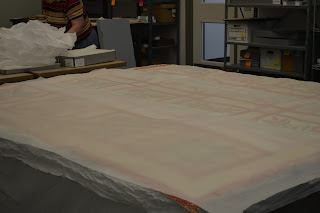The Benton County Museum just closed its quilt exhibition for the year, so it seems timely to offer a look at how we preserve them for the enjoyment of future generations. Quilts are common heirloom that contain a lot of family history, and their long term preservation can be quite simple if the right materials and techniques are used.
This blog is going to start with a short explanation about the photo quality. We decided to shoot the quilts as an action process, thus there may be some blurs here and there as people move around. Mary Gallagher, the collections manager, is particularly talented at being a blur because she is constantly in motion getting something done. It's a trait we at the museum are quite fond of, thus excusing a bit of blur seems the least we could do.
Quilts and other large textiles such as flags and tapestries can be stored in one of three manners: rolling, boxing, or flat. Flat storage requires large amounts of space, reserved for textiles that are in poor condition or that are especially rare.
The cabinet has multiple doors that open for access, and textiles are placed on muslin on large drawers.
Rolling is a common method of long term storage for blankets, rugs, and quilts that don't have too much applique. The quilt is rolled around an archival tube and placed on racks.

Boxing is used for smaller items and quilts with heavy applique.
The first step in rolling a quilt is making sure your tube is of adequate diameter. When in doubt, bigger is better. You can buy archival tubes, or make your own by covering craft paper tubes with Marvel Seal (c). The tube Mary and Nancy are using is covered in Marvel Seal, and Mary is then covering it in stockinette, which helps hold the quilt in place.
The stockinette is similar to nylons, having to be nudged up a bit at a time. While Mary and Nancy slowly encourage it up the tube, Nan and Linda are folding kimonos in the background.
Excess stockinette at the end of the tube is tucked.
Mary and Nancy now examine their work surface, making sure it is clean of debris and anything that might harm their quilt.
Acid free tissue is used to cover the entire table, and a bit of extra is torn off at the top to act as a header.
The quilt is then unfolded onto the tissue, making sure the header is long enough.
Here Nancy inspects the quilt for condition issues while Mary prepares more tissue.
The tissue is laid over the entire quilt, just as it was on the front.
Here the importance of the header is shown. The header is an extra length of fabric used to start the rolling of the quilt and assure that tissue, and not the fabric, comes in contact with the tube.
The quilt is slowly rolled, making sure neither end telescopes out. In the background Rachel is cataloging a dress while Marcia is doing data entry.
Nancy holds the rolled quilt in place while Mary grabs some twill tape for tying the tissue in place.
The knot is tied gently, at the seam of the tissue to hold it on and maintain the roll of the quilt.
A sheet of Tyvek is cut to the length of the quilt. Tyvek provides a sturdy barrier for the quilt, it breathes, but is waterproof, and isn't susceptible to tearing like tissue is. 
The Tyvek is wrapped around the quilt, and again with cotton twill, but not too tightly. 
The roll is transported to the racks, and a hanging tube is carefully inserted.
This quilt happened to be on one of the higher racks, so Mary used the ladder to slowly take the quilt up.
Nancy provided the support on the floor. Once the quilt was safely on the rack, an identification tag with the quilt's ID number and brief description are tied on the end of the tube.
Below are two pictures of the quilt out of its rolled state. It was made in 1840 and was part of the Horner Collection from OSU.

Boxing quilts contains many of the same processes that rolling does, such as covering the quilt on both sides with acid free tissue. The quilt Mary and Nancy will be boxing is from 1845 and is an "album quilt" Many of the squares contain the names of those that worked on it. The fabric has deteriorated in a peculiar manner over the years, one of the dyes in a particular flower pattern has dissolved the fabric.
Nancy begins by unfolding the quilt, checking for any sort of insect damage or anything else not currently noted in the file.
The top is also covered with acid free tissue
Mary and Nancy the measure the quilt, determining how many folds are necessary to fit it into the box. This information is also catalog in the record for future reference.
Folding begins, with care to not make sharp, knife edge creases, but soft round corners.
This process is aided by rolled up tissue which provides internal support for each fold.
The quilt is folded several times, with rolled up tissue placed between each fold.
The box is lined with a muslin sling, similar to the one used for gowns, to provide easy lifting.
Mary notes the size of the box relative to the size of the quilt.
The quilt is folded, wrapped in muslin, and tucked into the box. The box is labeled with the ID number and identifying notes, and taken to the appropriate shelf.
The Minnesota Historical Society offers some great tips on how to roll and box quilts and other textiles.




















































